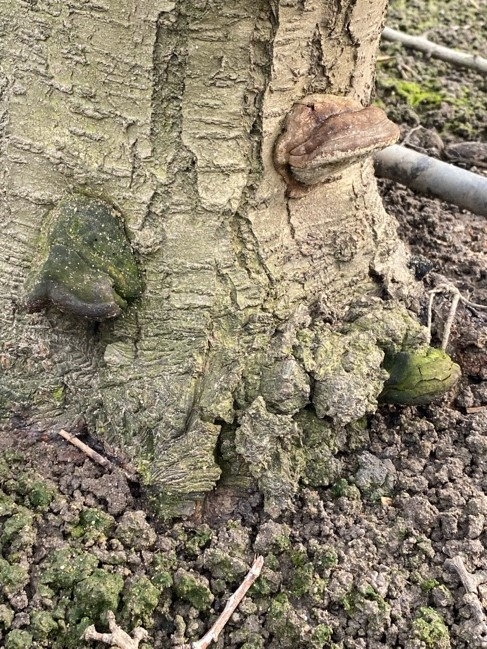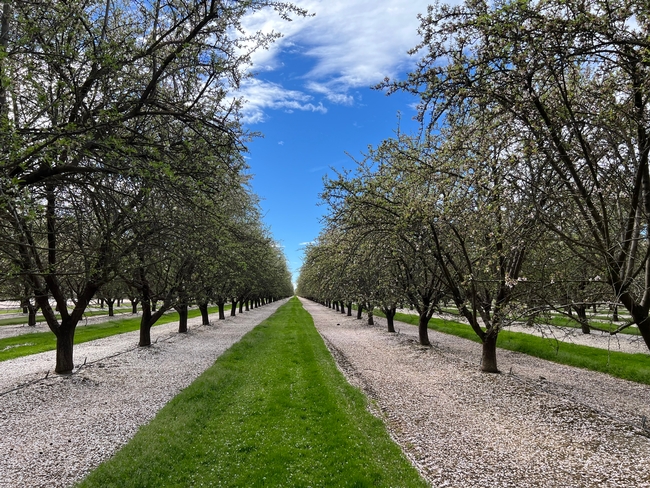- Author: Raymond Mireles
- Author: Mohammad Yaghmour
- Author: Santosh Bhandari
- Author: Elizabeth J Fichtner
Within the past decade a wood decay fungus with no prior record in North America has emerged as a pathogen of almond, prune, and peach (rootstock) in the San Joaquin Valley. Since 2016, Ganoderma adspersum, has been associated with decay symptoms on almonds in Kings, Tulare, Kern, and Madera counties. Unlike other endemic species of Ganoderma that were previously recognized in California almond orchards, G. adspersum appears to be aggressive on young trees, particularly those on ‘Nemaguard' rootstock. Additionally, G. adsperum infection appears to be prevalent in orchards with high incidence of crown gall caused by Agrobacterium tumefaciens, leading plant pathologists to suspect that the bacterial disease may predispose infected almond trees to the decay fungus. After a recent farm call with almond growers and crop consultants, UCCE Advisors Mohammad Yaghmour, Elizabeth Fichtner, and Raymond Mireles have initiated a series of studies to further investigate the potential relationship between crown gall and G. adspersum in the field, as well as evaluate techniques to limit the spread of G. adspersum in orchards.
Ganoderma adspersum is a wood decay fungus that infects the roots and butts of trees causing white rot and leading to tree blow-over and mortality especially after windy and rainy storms, hence, it is also called butt rot. Infected trees may appear healthy but are more likely to collapse during storms or harvest activities than uninfected trees.
In February 2024, Yaghmour, Fichtner, and Mireles established new research studies in Tulare County orchards to address the hypothesis that G. adspersum infections are more prevalent on trees infected with A. tumefaciens. With the assistance of Santosh Bhandari, Associate Specialist with UC ANR, over 6,000 trees were surveyed across two orchards and rated for incidence of each disease. Both orchards were on ‘Nemaguard' rootstock and included ‘Nonpareil,' ‘Monterey,' and ‘Fritz' varieties. Results of statistical analyses indicate a significant association between G. adspersum and crown gall infection on all varieties in both orchards. For each incident of crown gall, the probability of infection with G. adspersum increased by over 80-fold across all varieties in both orchards.
Studies conducted by Daisy Hernandez, a PhD student in the Department of Plant Pathology at UC Davis, suggest that stem infections with crown gall do not alter the tree's susceptibility to future infection with G. adspersum at another location on the stem. This work suggests that the association of the two diseases may not be related to a physiological change in the plant resulting from prior infection with A. tumefaciens; however, it does not rule out other mechanisms of predisposition. Mireles, Yaghmour, and Fichtner are interested in studying whether the crown gall itself presents a unique infection court (ie. opening) that facilitates infection with windblown spores of G. adspersum that may encounter the gall years after crown gall development.
In 2024, new studies will be initiated to evaluate the potential benefit of phosphites (ie. K-Phite®) in limiting the progression of new infections of G. adspersum in affected almond orchards. Phosphites offer a cost-effective approach at managing several plant diseases, including Phytophthora on almonds. Phosphites are known to induce plant defense responses to disease and are often better at preventing than curing disease. Additionally, some growers have expressed interest in using conk-removal as a strategy for reducing G. adspersum inoculum in orchards. UCCE Advisors plan to evaluate the influence of phosphite treatment on the rate of fruiting body regrowth with the anticipation of identifying multiple techniques that growers may employ to mitigate the economic effects of these diseases in California orchards.



